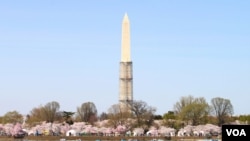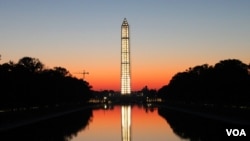WASHINGTON —
The Washington Monument, one of the U.S. capital’s most recognizable landmarks, reopens Monday, three years after sustaining earthquake damage. The 130-year old, 170-meter-tall marble obelisk sustained more than 150 cracks after a rare 5.8-magnitude earthquake in August 2011.
The monument, located in the heart of the city’s National Mall, was shaken by the August 23 earthquake, whose epicenter was about 145 kilometers southwest of Washington. Falling mortar and pieces of stone struck visitors inside causing minor injuries. Everyone was safely evacuated.
A post-quake assessment revealed cracks, spalls (breaks or splintering) and displacement of stones and joints, forcing its closure to the public. The structure was covered by scaffolding as it underwent repairs at a cost of $15 million. Half the repair cost was paid for by businessman and philanthropist David Rubenstein.
"Most of the earthquake damage that this building sustained back in 2011 was at the upper levels of the monument, and that required a very elaborate scaffolding system and expert stone masons, who could come and do the repairs here,” said James Perry of the National Mall and Memorial Parks, an administrative unit of the National Park Service, which oversees the capital city’s national memorials.
New exhibits have been installed at the Washington Monument and visitors can once again ride an elevator to the top, the highest point in the federal city.
Construction of the monument, a tribute to George Washington, the nation’s first president, began as a private venture in 1848. The construction faced many difficulties. First, funds ran out, and later on the Civil War interrupted building efforts until Congress authorized resumption of construction in 1876. The monument was finally completed in 1884 and dedicated the following year.
It was the world’s tallest structure until completion of the Eiffel Tower in Paris in 1889, and attracts about 800,000 visitors a year.
The monument, located in the heart of the city’s National Mall, was shaken by the August 23 earthquake, whose epicenter was about 145 kilometers southwest of Washington. Falling mortar and pieces of stone struck visitors inside causing minor injuries. Everyone was safely evacuated.
A post-quake assessment revealed cracks, spalls (breaks or splintering) and displacement of stones and joints, forcing its closure to the public. The structure was covered by scaffolding as it underwent repairs at a cost of $15 million. Half the repair cost was paid for by businessman and philanthropist David Rubenstein.
"Most of the earthquake damage that this building sustained back in 2011 was at the upper levels of the monument, and that required a very elaborate scaffolding system and expert stone masons, who could come and do the repairs here,” said James Perry of the National Mall and Memorial Parks, an administrative unit of the National Park Service, which oversees the capital city’s national memorials.
We are sorry, but this feature is currently not available
New exhibits have been installed at the Washington Monument and visitors can once again ride an elevator to the top, the highest point in the federal city.
Construction of the monument, a tribute to George Washington, the nation’s first president, began as a private venture in 1848. The construction faced many difficulties. First, funds ran out, and later on the Civil War interrupted building efforts until Congress authorized resumption of construction in 1876. The monument was finally completed in 1884 and dedicated the following year.
It was the world’s tallest structure until completion of the Eiffel Tower in Paris in 1889, and attracts about 800,000 visitors a year.








